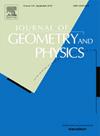奇异七球的曲率
IF 1.2
3区 数学
Q1 MATHEMATICS
引用次数: 0
摘要
我们研究了Gromoll-Meyer球的几何,它是Milnor的奇异7球之一。我们关注Kaluza-Klein Ansatz,以圆形S4作为基空间,单位S3作为纤维,k=1,2 SU(2)实例作为规范场,其中所有的量都可以用四元数语言进行优雅的描述。度规的模空间与k=1,2瞬时模空间相吻合,该瞬时模空间由基的等距所商,加上一个额外的R+因子,对应于基的半径R。我们确定了k=2瞬时模空间的一个“中心”,具有增强的对称性。此k=2解与最大对称k=1解一起使用,以获得最大等距度量SO(3)×O(2),并显式计算其里奇张量。这允许我们给r设定一个界限以确保里奇曲率为正,这意味着8维静态时空的各种能量条件。这样的构造就可以对截面曲率的特性进行具体的检验。本文章由计算机程序翻译,如有差异,请以英文原文为准。
Curvature of an exotic 7-sphere
We study the geometry of the Gromoll–Meyer sphere, one of Milnor's exotic 7-spheres. We focus on a Kaluza–Klein Ansatz, with a round as base space, unit as fibre, and instantons as gauge fields, where all quantities admit an elegant description in quaternionic language. The metric's moduli space coincides with the instantons' moduli space quotiented by the isometry of the base, plus an additional factor corresponding to the radius of the base, r. We identify a “center” of the instanton moduli space with enhanced symmetry. This solution is used together with the maximally symmetric solution to obtain a metric of maximal isometry, , and to explicitly compute its Ricci tensor. This allows us to put a bound on r to ensure positive Ricci curvature, which implies various energy conditions for an 8-dimensional static space-time. This construction then enables a concrete examination of the properties of the sectional curvature.
求助全文
通过发布文献求助,成功后即可免费获取论文全文。
去求助
来源期刊

Journal of Geometry and Physics
物理-物理:数学物理
CiteScore
2.90
自引率
6.70%
发文量
205
审稿时长
64 days
期刊介绍:
The Journal of Geometry and Physics is an International Journal in Mathematical Physics. The Journal stimulates the interaction between geometry and physics by publishing primary research, feature and review articles which are of common interest to practitioners in both fields.
The Journal of Geometry and Physics now also accepts Letters, allowing for rapid dissemination of outstanding results in the field of geometry and physics. Letters should not exceed a maximum of five printed journal pages (or contain a maximum of 5000 words) and should contain novel, cutting edge results that are of broad interest to the mathematical physics community. Only Letters which are expected to make a significant addition to the literature in the field will be considered.
The Journal covers the following areas of research:
Methods of:
• Algebraic and Differential Topology
• Algebraic Geometry
• Real and Complex Differential Geometry
• Riemannian Manifolds
• Symplectic Geometry
• Global Analysis, Analysis on Manifolds
• Geometric Theory of Differential Equations
• Geometric Control Theory
• Lie Groups and Lie Algebras
• Supermanifolds and Supergroups
• Discrete Geometry
• Spinors and Twistors
Applications to:
• Strings and Superstrings
• Noncommutative Topology and Geometry
• Quantum Groups
• Geometric Methods in Statistics and Probability
• Geometry Approaches to Thermodynamics
• Classical and Quantum Dynamical Systems
• Classical and Quantum Integrable Systems
• Classical and Quantum Mechanics
• Classical and Quantum Field Theory
• General Relativity
• Quantum Information
• Quantum Gravity
 求助内容:
求助内容: 应助结果提醒方式:
应助结果提醒方式:


